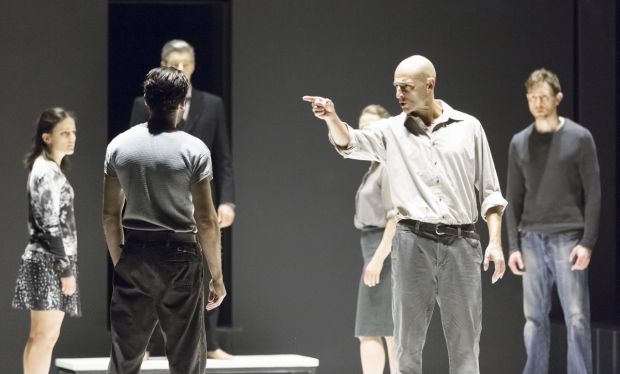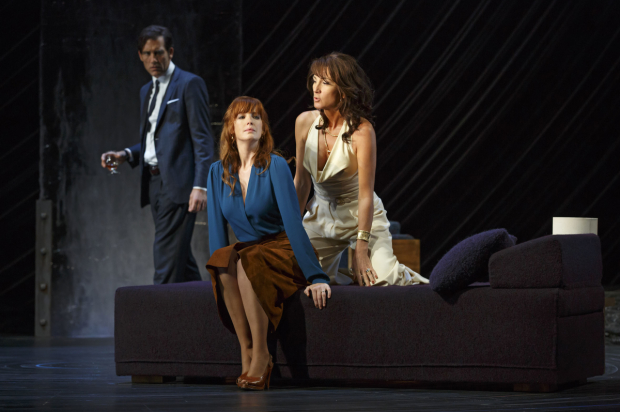Ibsen the Inevitable (Part II)
This is part II of Michael Feingold's latest "Thinking About Theater" column. Click here to read part I.

(© Jan Versweyveld)
Before he was established as a playwright, Henrik Ibsen (1828-1906) had already attracted notice as a promising poet. Before he wrote the plays for which he is best known today — the 12-play cycle referred to as his "realistic" or "domestic" plays — he had spent over two decades becoming a major European figure in a wholly different realm of playwriting. Until Pillars of Society, the play on which Arthur Miller modeled All My Sons, appeared in 1877, Ibsen was known chiefly as a writer of large-scale, post-Shakespearean dramas, historical or philosophic, of the kind with which writers like Goethe and Schiller had inaugurated the Romantic movement nearly a century earlier.
This prolonged apprenticeship produced some texts that remain both significant and theatrically viable. The two still most familiar, ironically, were both originally written to be read rather than staged. Yet the theatrical imagination behind Brand (1866) and Peer Gynt (1867) packed so much power that people immediately began performing excerpts from both in public readings, and both fairly soon found their way into the world's repertoire. (Peer Gynt got an extra boost from the immense popularity of the incidental music that Edvard Grieg composed for its first production, in 1876.)
When Ibsen moved away from the gigantic extremes of verse drama, he brought its great philosophic conflicts with him into the living rooms of the contemporary world. That was how he invented modern drama. The "well-made play," as perfected in France by writers like Eugène Scribe and Alexandre Dumas fils, had kept its ideas trivial. Whether an aristocrat should marry an actress, or a courtesan sacrifice herself to rescue the man she loves, was the most serious sort of issue their plays tackled. Scribe and his imitators had used the great political and religious conflicts of European history as excuses for love triangles and jealousy melodramas; you can still see the results, embedded in great music, when the Met performs works like Verdi's Ballo in maschera and Puccini's Tosca.
Ibsen set his sights on bigger intellectual game. Within the taut, quid-pro-quo structure devised by Scribe, he infused the everyday life he observed around him with the issues — moral, ethical, economic, and political — that the new urbanized world of the Industrial Revolution had created. He looked deep into the heart of that world's smug and self-justifying upper middle class, dissecting the hidden rot at its core. George Bernard Shaw, one of his most enthusiastic early admirers, once imagined a future in which Ibsen was canonized as a saint: On the base of his monument, Shaw puckishly conjectured, his worshipers would quote him as saying, "I came to call, not sinners, but the righteous, to repentance."

(© Friedman-Abeles)
Seeing how easily righteousness could morph into self-righteousness, Ibsen sent 19th-century conservatives — and censors — into furies. Nora Helmer, slamming the door on her respectable marriage and her children, provoked such outcries that prominent actresses refused to play A Doll's House. Ibsen placated them with an alternate ending in which Torvald forces her to the door of the children's bedroom. She stays, but wails that she is "committing the gravest sin against myself." (The happy endings Ibsen wrote, uncoerced, for later works like The Lady From the Sea and Little Eyolf are hardly less disquieting.)
While Nora's door-slam was reverberating across Europe, Ibsen got respectable doors slammed in his own face by writing what might happen to a woman who didn't walk out on a sham marriage: Ghosts (1881). Syphilis, incest, adultery, arson, pimping, insurance fraud, and assisted suicide — all with a hollowly pious minister for a non-hero and a descent into dementia for a finale. Published to catch the Christmas market, it was a booksellers' disaster, banned from theaters by every European censor. The world premiere, in Danish, took place in Chicago. "A dirty act done publicly" (London Times) was one of the kinder things said about it when it finally reached the European stage — most often in small "independent" or private-club theaters created for its sake.
What saved Ibsen for the mainstream, while the press was still describing his enthusiasts as "sexless cranks," was actors, and particularly actresses. They couldn't keep away from the huge, juicy roles and exciting scenes he wrote: Richard Mansfield and Herbert Beerbohm Tree; Mrs. Fiske and Mrs. Patrick Campbell; Duse and Nazimova all carried Ibsen's banner. Great directors, from Max Reinhardt and Stanislavsky down to Ingmar Bergman were hardly less immune to the exciting temptations he offered.

(© Joan Marcus)
Most of all, though, it was the playwrights — a full century's worth of them — who absorbed with joy Ibsen's merger of playmaking skill with thematic grandeur. Strindberg, Chekhov, and Schnitzler all grumbled about his influence yet carried it within their sensibility. Like Arthur Miller, O'Neill and Odets, Lillian Hellman and Lorraine Hansberry, embraced his structural sense. You can find his heritage in Albee, in Mamet, and even in far less expectable places: the old man who isn't there, disrupting the ostensible naturalism of Shepard's Fool for Love; the significantly misphrased remark ("You have a wonderful casserole. I mean wife.") in Pinter's Old Times (compare Hedda Gabler's "mistake" about Aunt Juliana's hat).
Even that most un-Ibsenite of playwrights, Samuel Beckett, took a clue from Pillars of Society, whose characters include a dour, obsequious clerk named Krap: Beckett merely tacked a second "p" onto his name and handed him a tape recorder. And Ibsen finds a sort of crazy-house resting place in Charles Ludlam's Mystery of Irma Vep, which is packed with buried allusions to the late Ibsen plays that touch on the supernatural, like Rosmersholm and Little Eyolf.
So as we honor Miller, let us love and celebrate Ibsen, who taught us not only how to build plays but how to use, in their building, the true materials of our lives — a guaranteed way to make the buildings last. Beyond that, he taught the best thing a great artist can teach: that not everything we do can be explained. The "social message" of an Ibsen play is only the tip of the iceberg; under it lies the whole terrifying tangle of human relationships and desires. That thinkers like Sigmund Freud, Henry James, and James Joyce were fascinated by Ibsen is no accident. The Living Theatre's first version of Frankenstein contained a sequence (never played in the U.S.) in which the monster wandered through the climactic scenes from Ibsen's twelve domestic plays. When I asked Judith Malina why they had done this, she said, "Because no one articulates the crises in our daily lives more accurately than Ibsen." It's still true.
Michael Feingold's next two-part "Thinking About Theater" column will appear on consecutive Fridays December 18 and 25.
Michael Feingold has twice won the George Jean Nathan Award for Dramatic Criticism, most recently in 2015 for his "Thinking About Theater" columns on TheaterMania, and has twice been a finalist for the Pulitzer Prize in Criticism. He serves as chairman of the Obie Awards and has also worked as a playwright, translator, and dramaturg.










